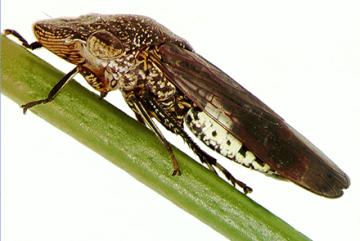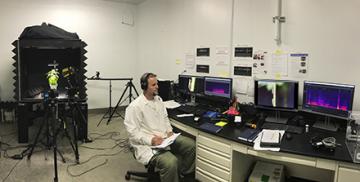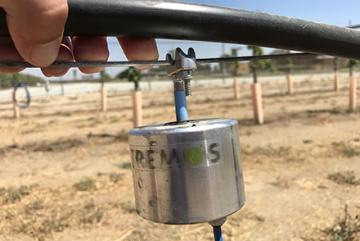How Do You Confuse a Sharpshooter?

An adult glassy-winged sharpshooter, Homalodisca vitripennis. (Rodrigo Krugner, D4201-1)
Video: USDA ARS entomologists "Turn Up the Bass" on Vineyard Pests
Rodrigo Krugner, an entomologist with the Agricultural Research Service (ARS) in Parlier, California, has found an innovative way to control insect pests in California vineyards: tapping into the vibrational signals they use as mating calls.
Krugner’s efforts have mainly focused on glassy-winged sharpshooters, which spread a bacterium that causes Pierce’s disease in vineyards and costs the California grape industry an estimated $104 million a year. Growers use chemical sprays to control the pests, but insecticides also kill beneficial insects, leave residues, and become less effective as the insects develop resistance.
Male and female glassy-winged sharpshooters produce mating calls by vibrating abdominal muscles, and they can detect each other’s signals from at least 6 feet away when they’re on the same vine. Krugner has developed a way to record those mating calls, study them, and turn them into sound waves that can be synthesized and played back to the sharpshooters in a vineyard—at a frequency that confuses the insects and disrupts their mating.

In the laser room at the Crop Diseases, Pests and Genetics Research Unit in Parlier California, ARS entomologist, Rodrigo Krugner listens to mating communication of glassy winged sharpshooters (GWSS). (Crystal Espindola, D4203-1)
In 2018, he published a paper showing the effectiveness of the technique in a California vineyard. “We found that playback of the right signal prevented insects from communicating, which resulted in no mating,” he says.
Krugner is now studying the vibrational signals of other insects that attack grapes so that the technique can be used to control them. At least 150,000 species of insects use vibrational signals as one method of attracting mates (some of them use pheromones combined with vibrations). Many of those insects, such as leafhoppers and stink bugs, attack grapes. The approach may hold its greatest potential for controlling vineyard pests, because grapevines have trellis networks that can be used as transmission lines for the signals, says Krugner, who works at ARS’s San Joaquin Valley Agricultural Sciences Center.
Each type of insect sends out a unique signal, but sound technology has advanced to a level where almost any vibration at any frequency can be replicated in a digital format, he says. The trick is being able to decipher the biological meaning of specific frequencies of the insect’s vibration and then synthesize it.

A custom made, prototype vibration emitter is placed on a trellis during field trials at the Crop Diseases, Pests and Genetics Research Unit in Parlier California. (Rodrigo Krugner, D4202-1)
“Most of the effort involves finding the right disruptive signal, similar to cracking a code in a different language, and then making a synthetic version of it,” Krugner says.
So far, he has characterized the vibrations used by the variegated leafhopper, which also attacks grapes. He has started to work on the vibrations emitted by the blue-green sharpshooter, another insect that spreads the Pierce’s disease bacterium in northern California and coastal vineyards.
The prototype “shaker” device Krugner uses to send signals through grapevines is suitable for use in fields, and while it isn’t widely available for commercial use, that may change. As Krugner and others develop disruptive signals for more insect pests, it should increase interest in the approach among growers—who are already very interested in cutting back on insecticide use. Once growers begin to want shakers of their own, manufacturers are likely to start producing them for commercial use, he says.—By Dennis O’Brien, ARS Office of Communications.
You May Also Like

